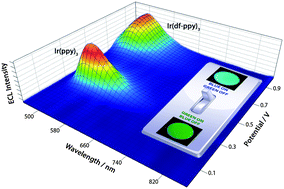A potential-controlled switch on/off mechanism for selective excitation in mixed electrochemiluminescent systems†
Abstract
We demonstrate the complete, rapid, and reversible switching between the emissions from two

* Corresponding authors
a
Department of Chemistry, La Trobe Institute for Molecular Sciences, La Trobe University, Victoria 3086, Australia
E-mail:
c.hogan@latrobe.edu.au
Tel: +61 3 9479 3747
b
Centre for Chemistry and Biotechnology, Faculty of Science and Technology, Deakin University, Victoria 3216, Australia
E-mail:
paul.francis@deakin.edu.au
Tel: +61 3 5227 1294
We demonstrate the complete, rapid, and reversible switching between the emissions from two

 Please wait while we load your content...
Something went wrong. Try again?
Please wait while we load your content...
Something went wrong. Try again?
E. H. Doeven, E. M. Zammit, G. J. Barbante, P. S. Francis, N. W. Barnett and C. F. Hogan, Chem. Sci., 2013, 4, 977 DOI: 10.1039/C2SC21707D
To request permission to reproduce material from this article, please go to the Copyright Clearance Center request page.
If you are an author contributing to an RSC publication, you do not need to request permission provided correct acknowledgement is given.
If you are the author of this article, you do not need to request permission to reproduce figures and diagrams provided correct acknowledgement is given. If you want to reproduce the whole article in a third-party publication (excluding your thesis/dissertation for which permission is not required) please go to the Copyright Clearance Center request page.
Read more about how to correctly acknowledge RSC content.
 Fetching data from CrossRef.
Fetching data from CrossRef.
This may take some time to load.
Loading related content
